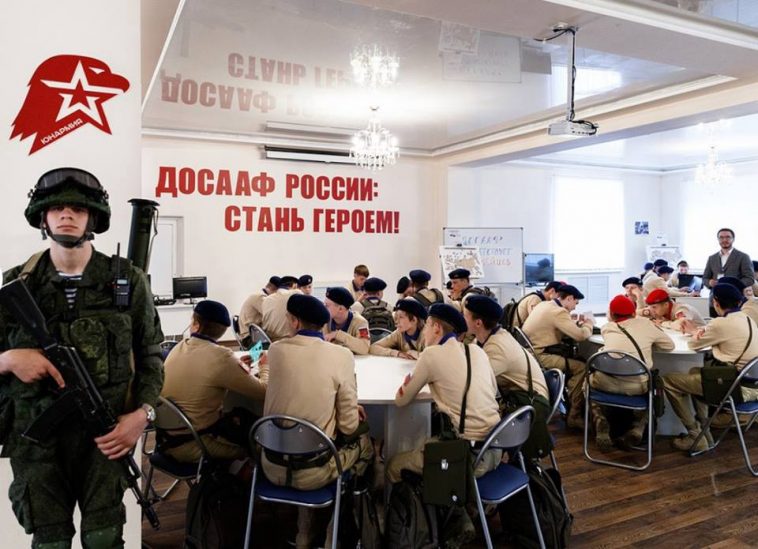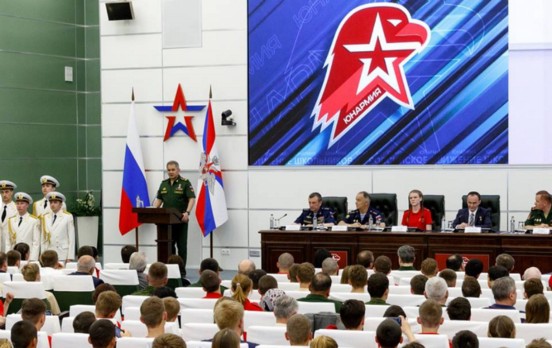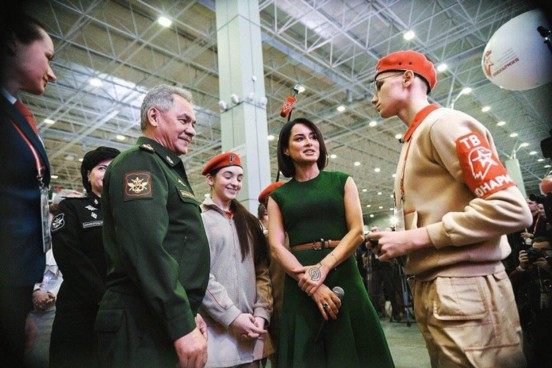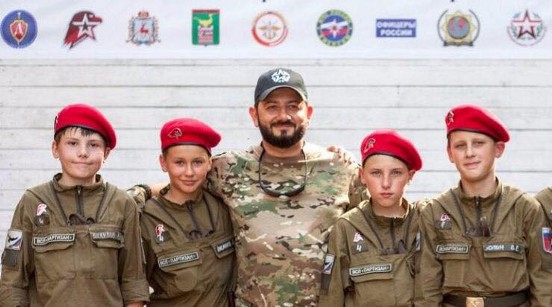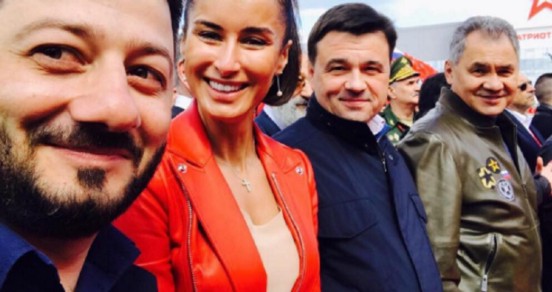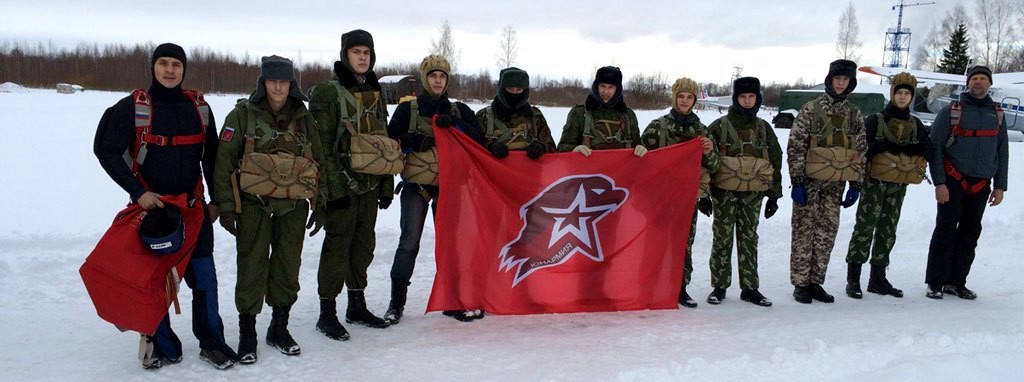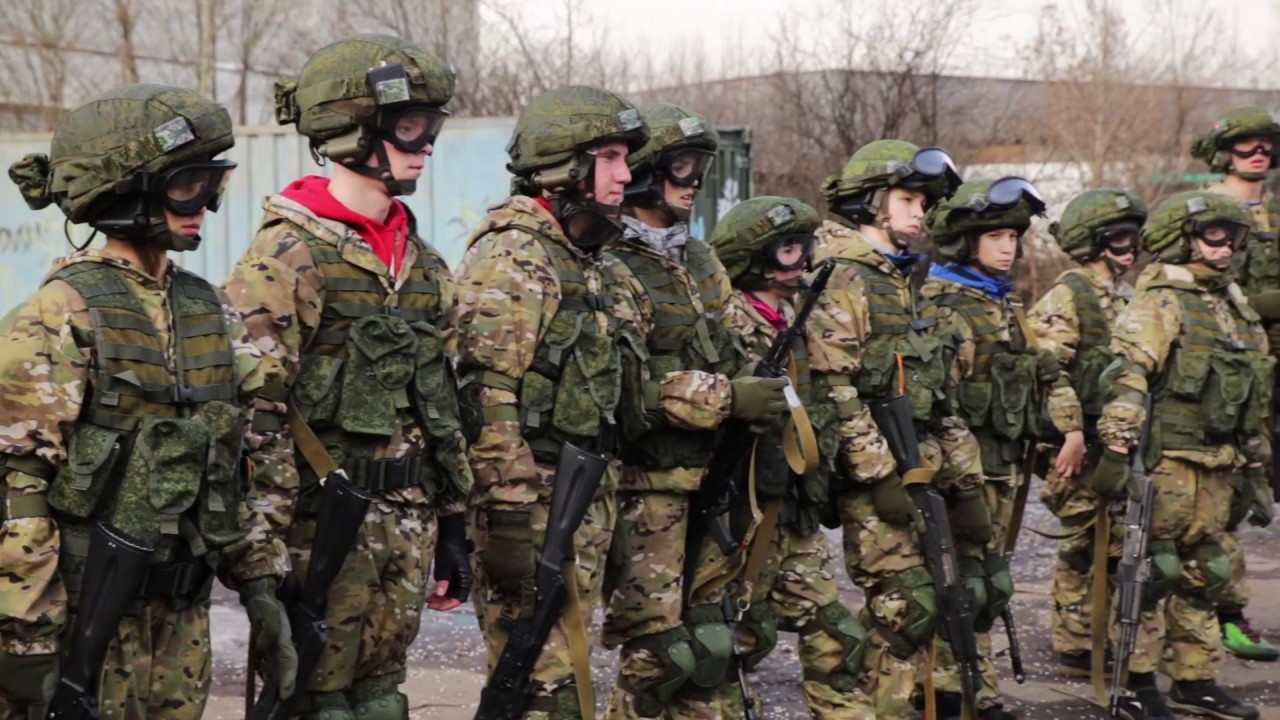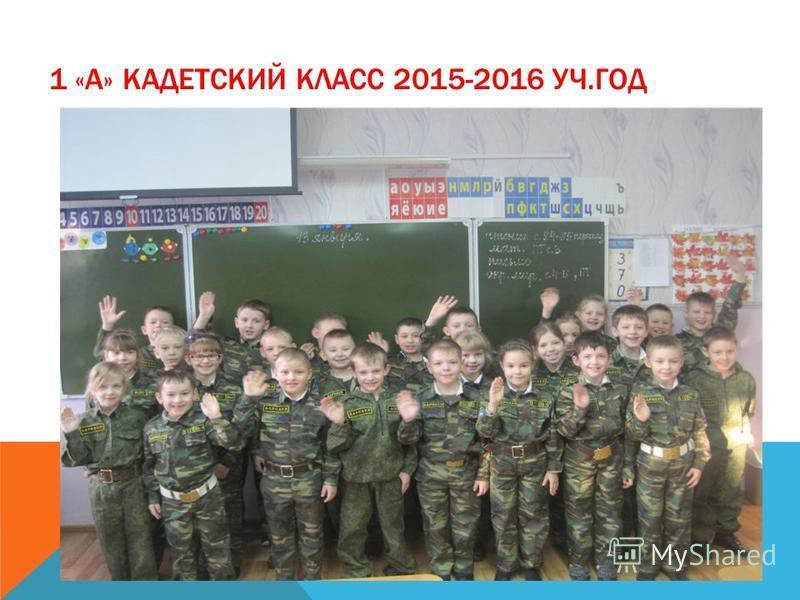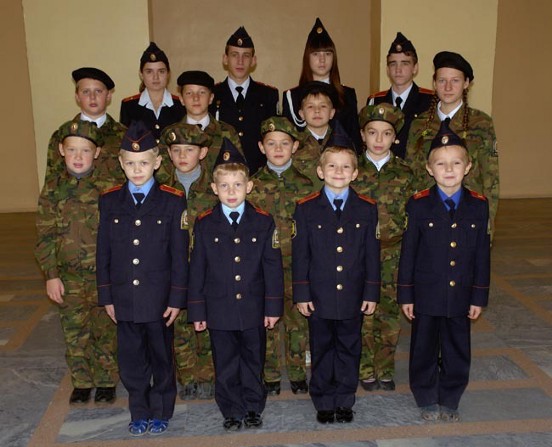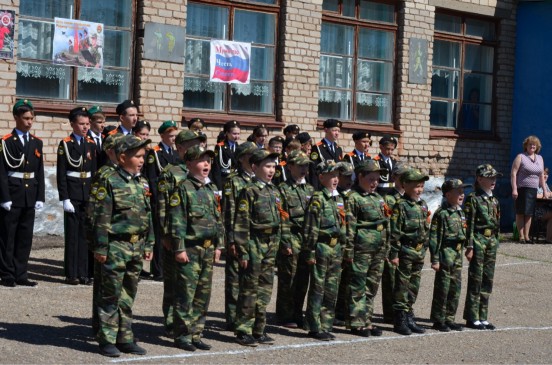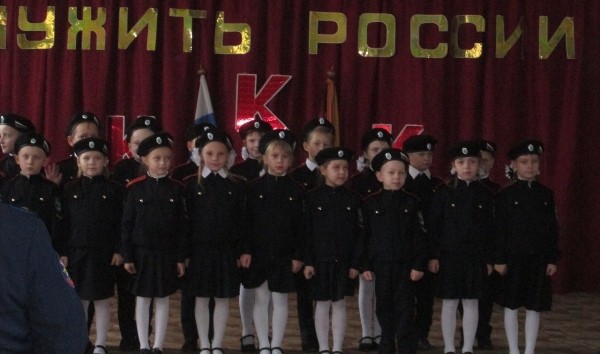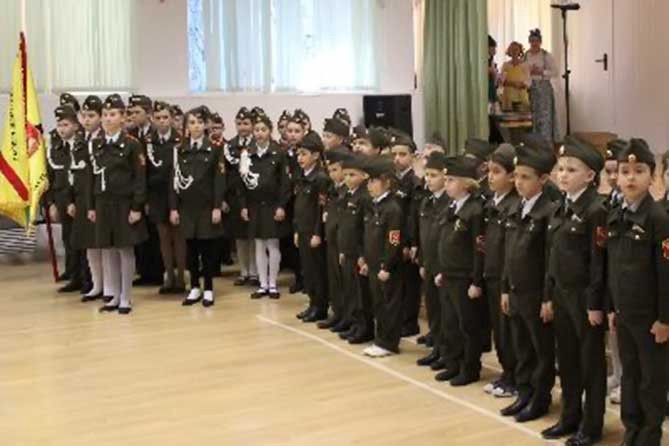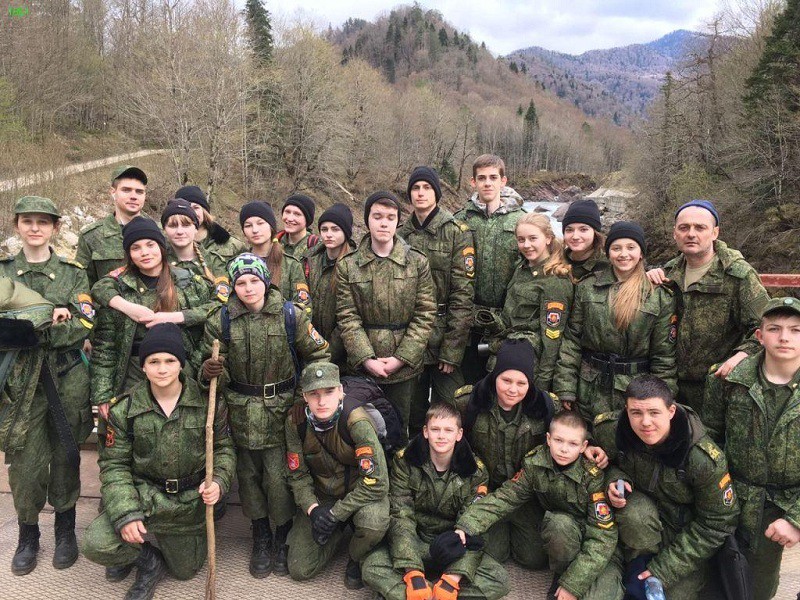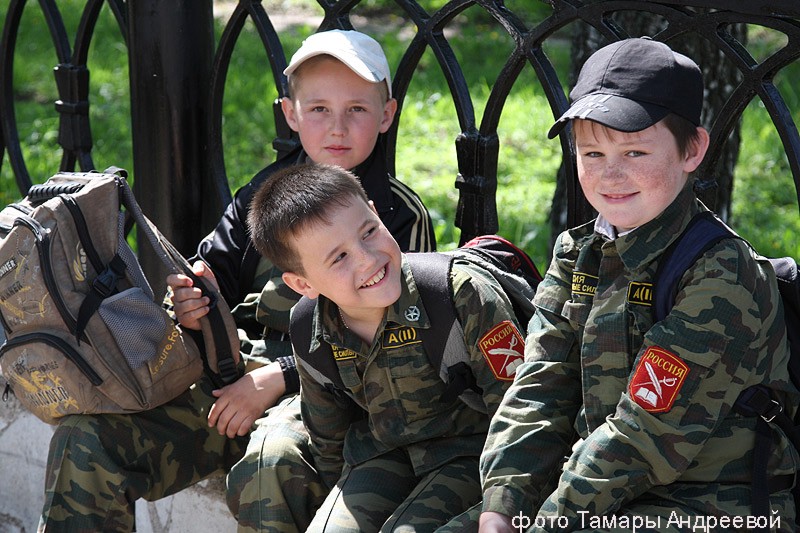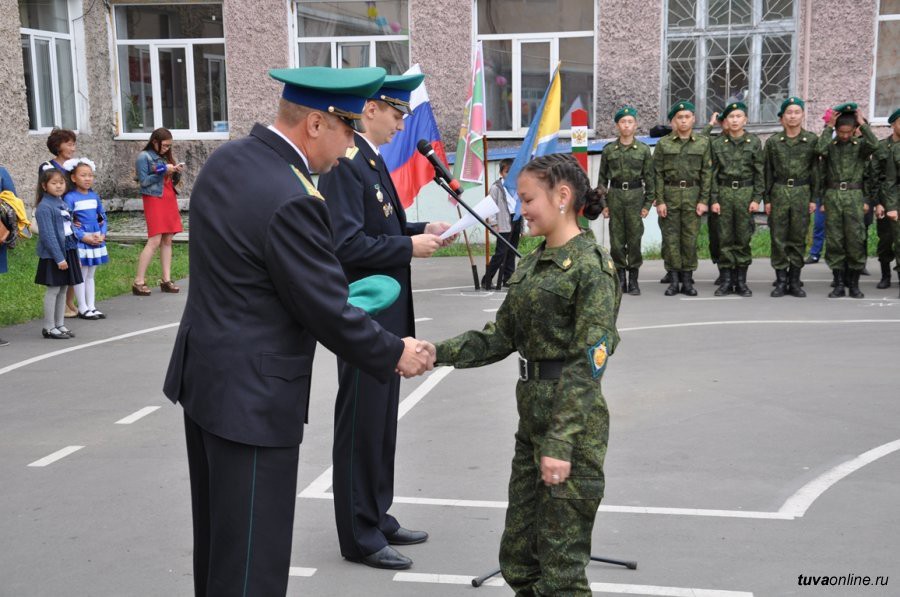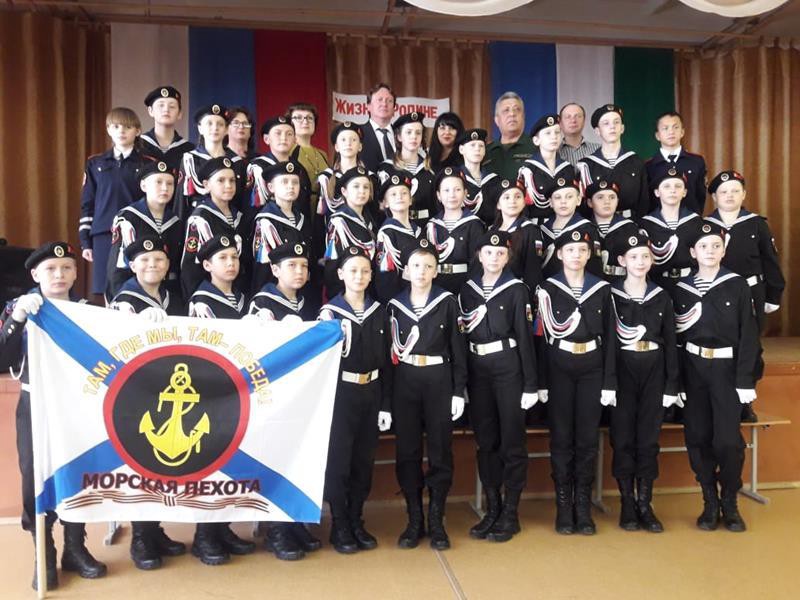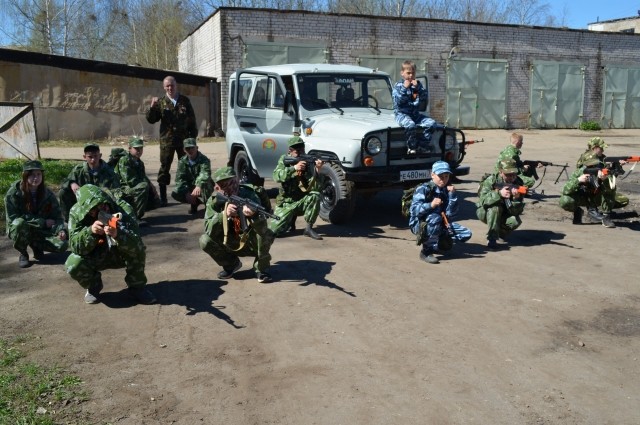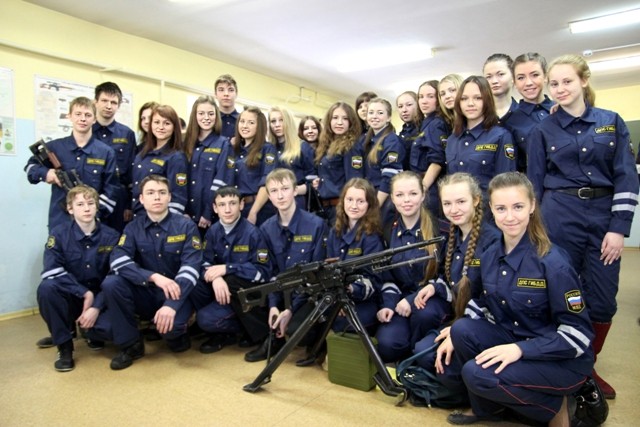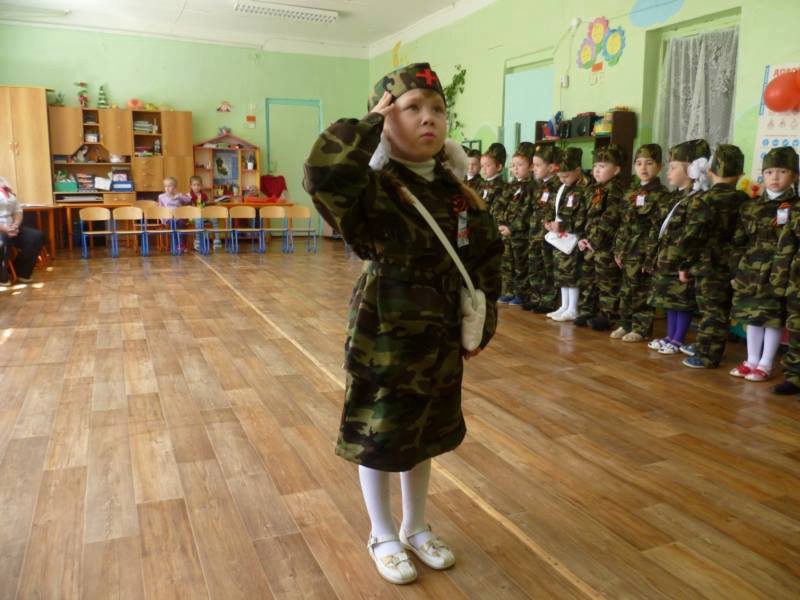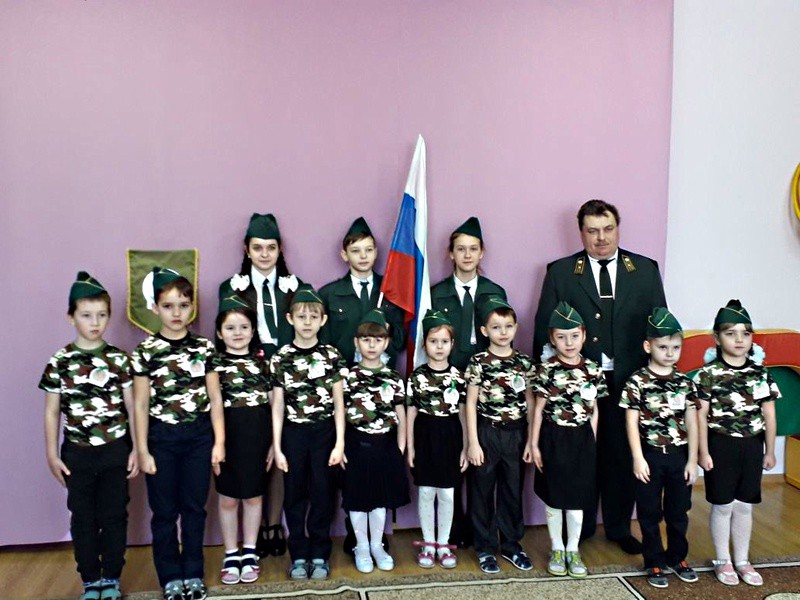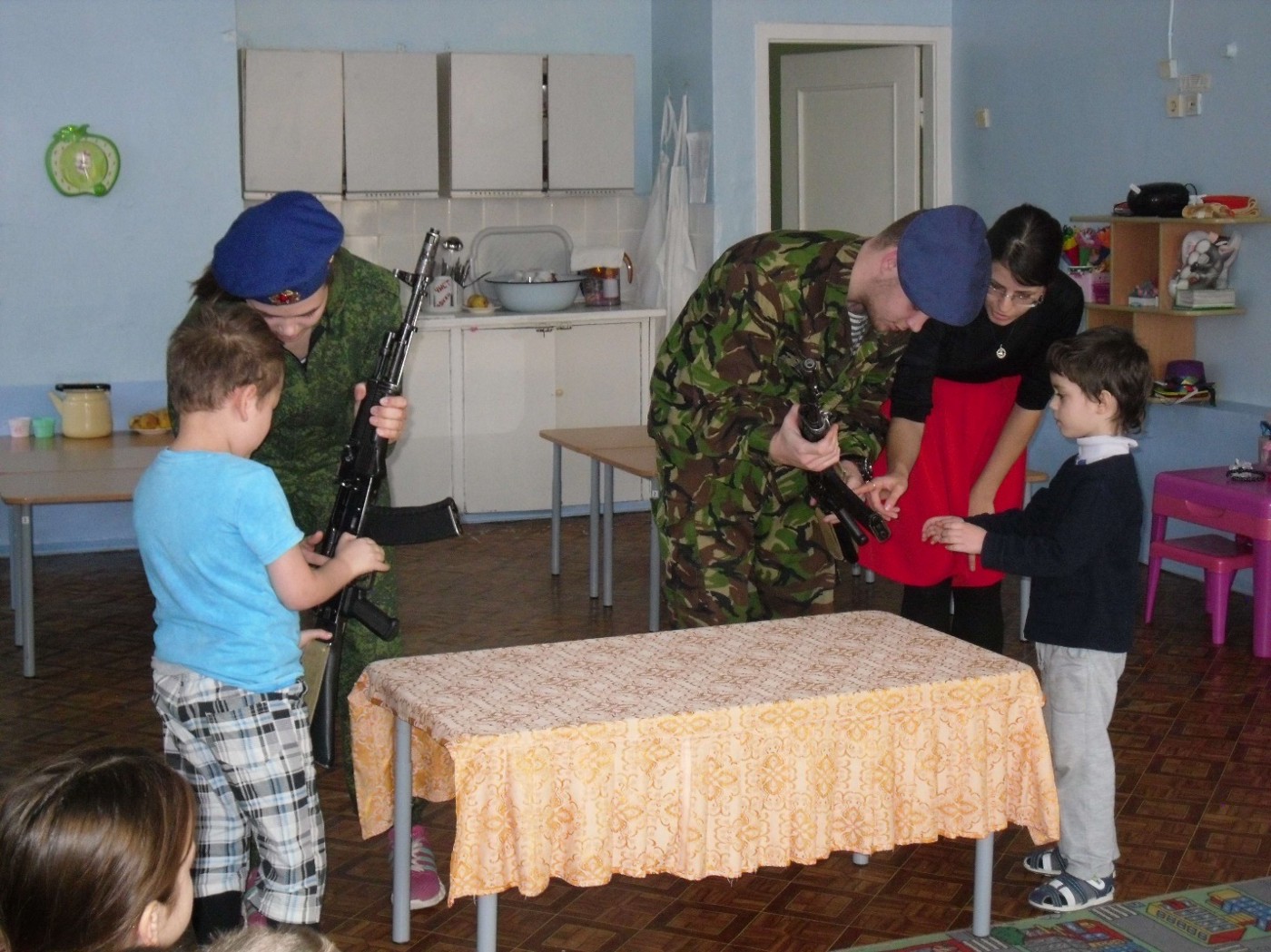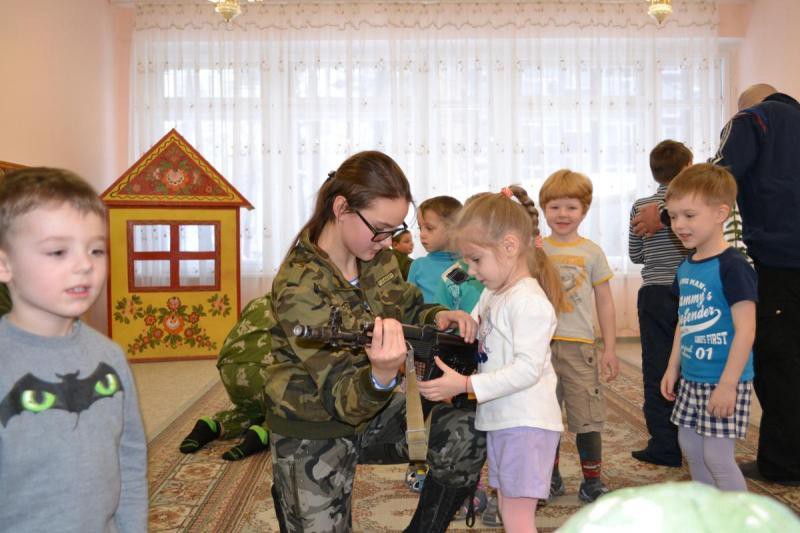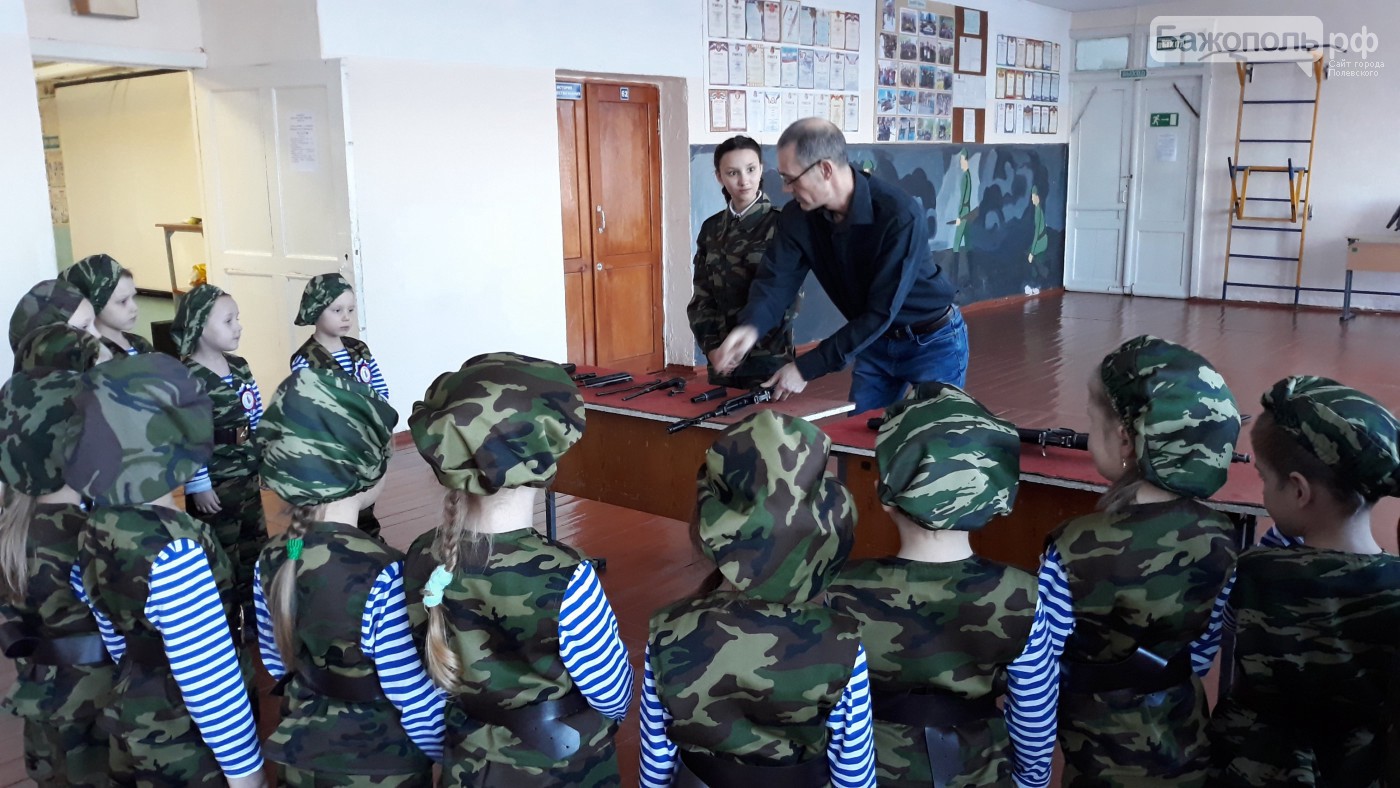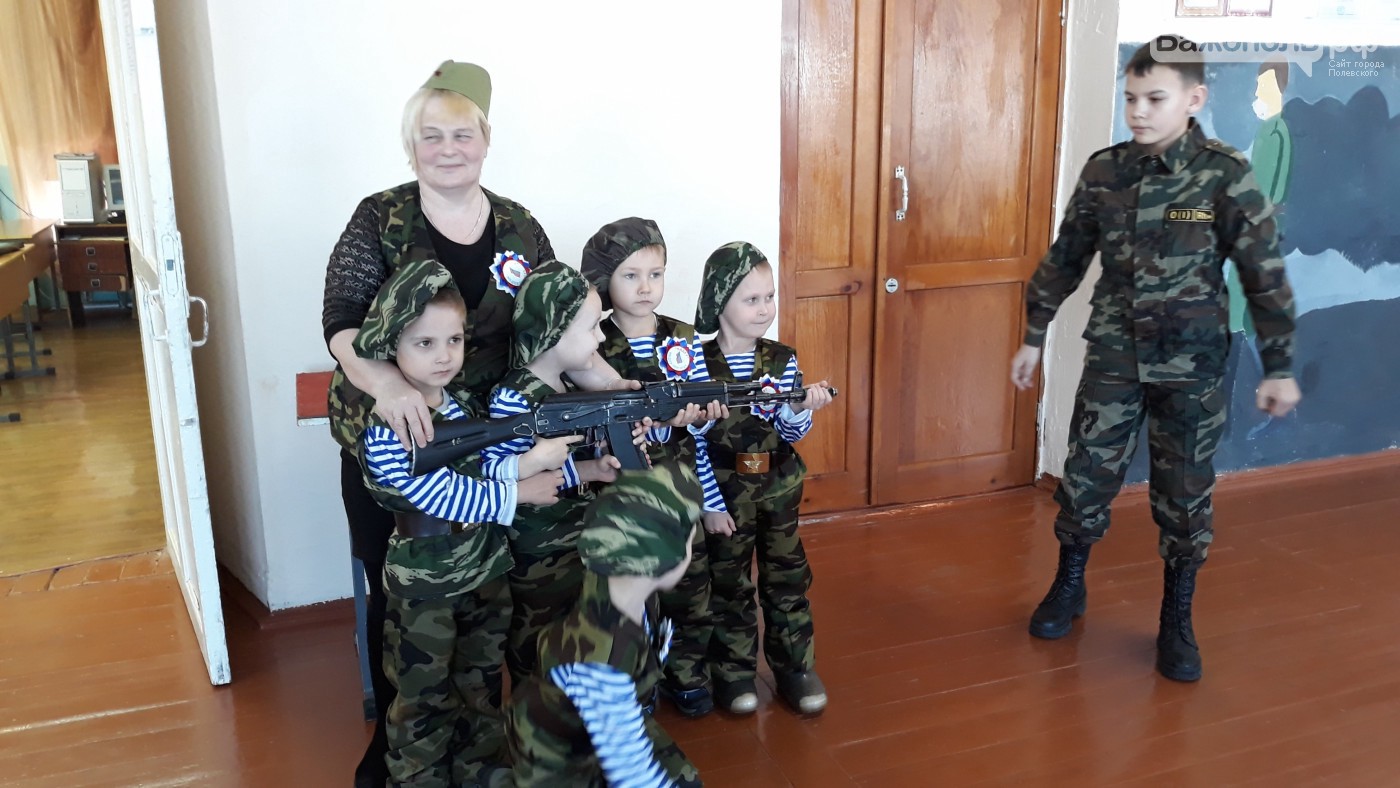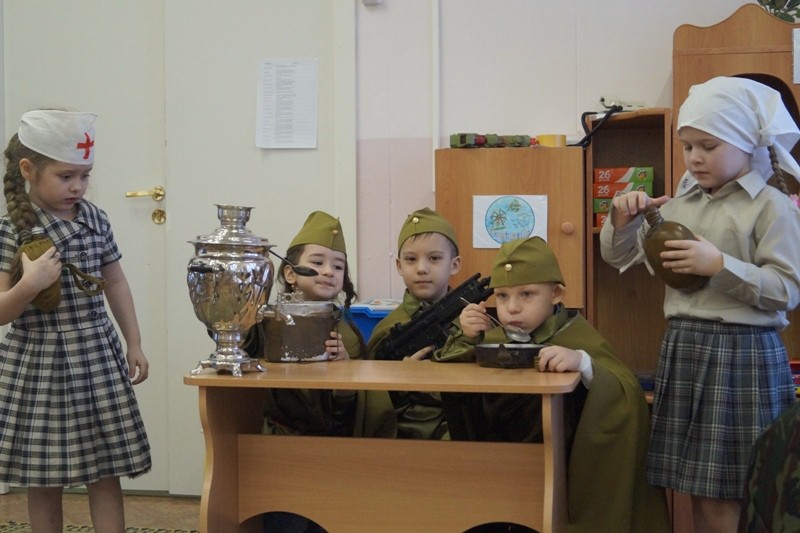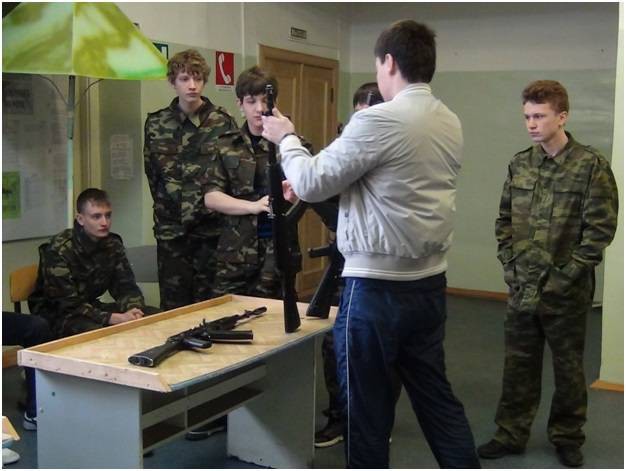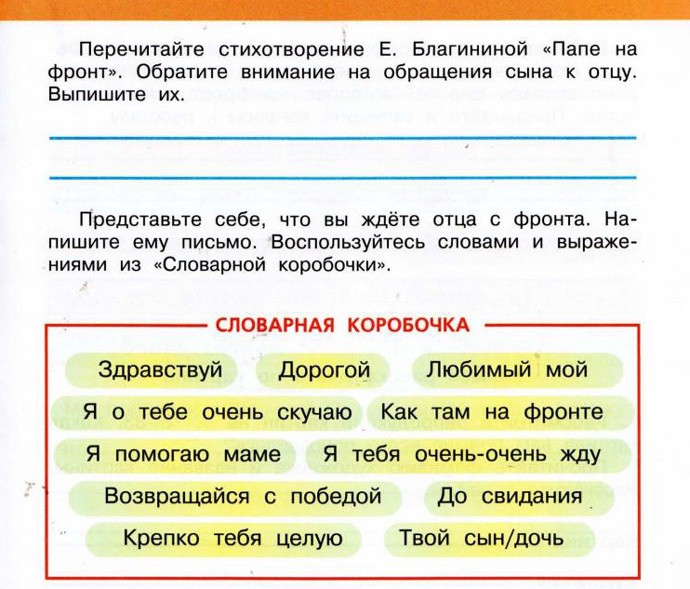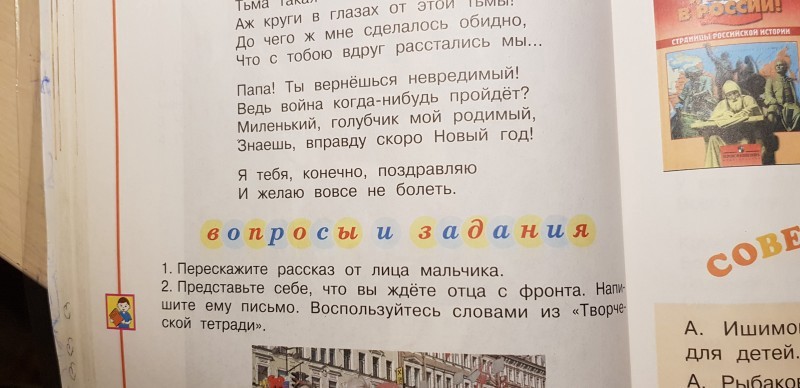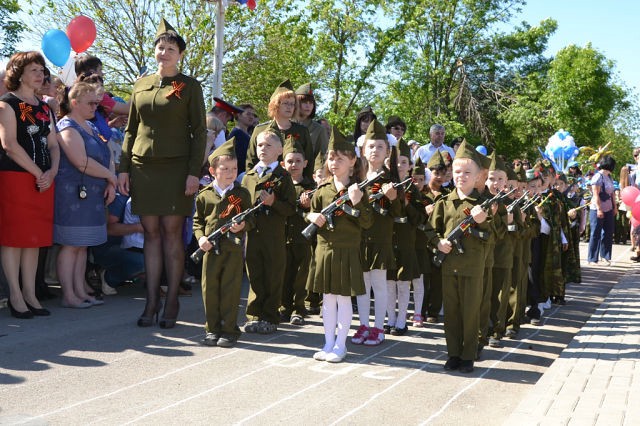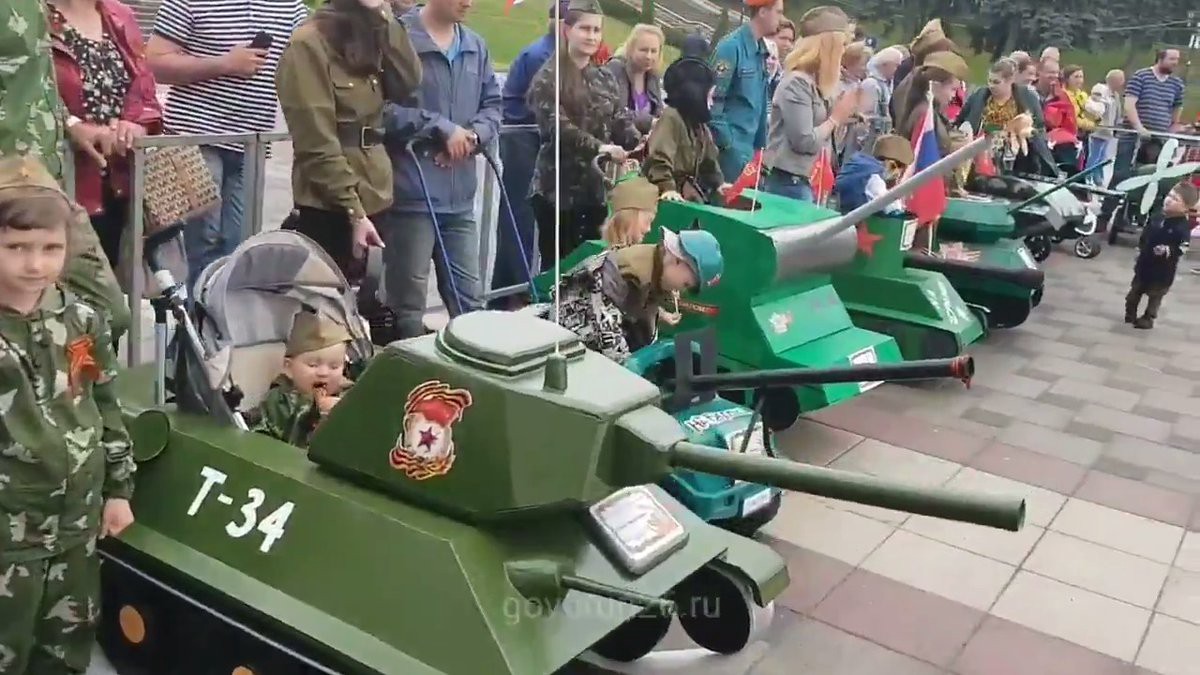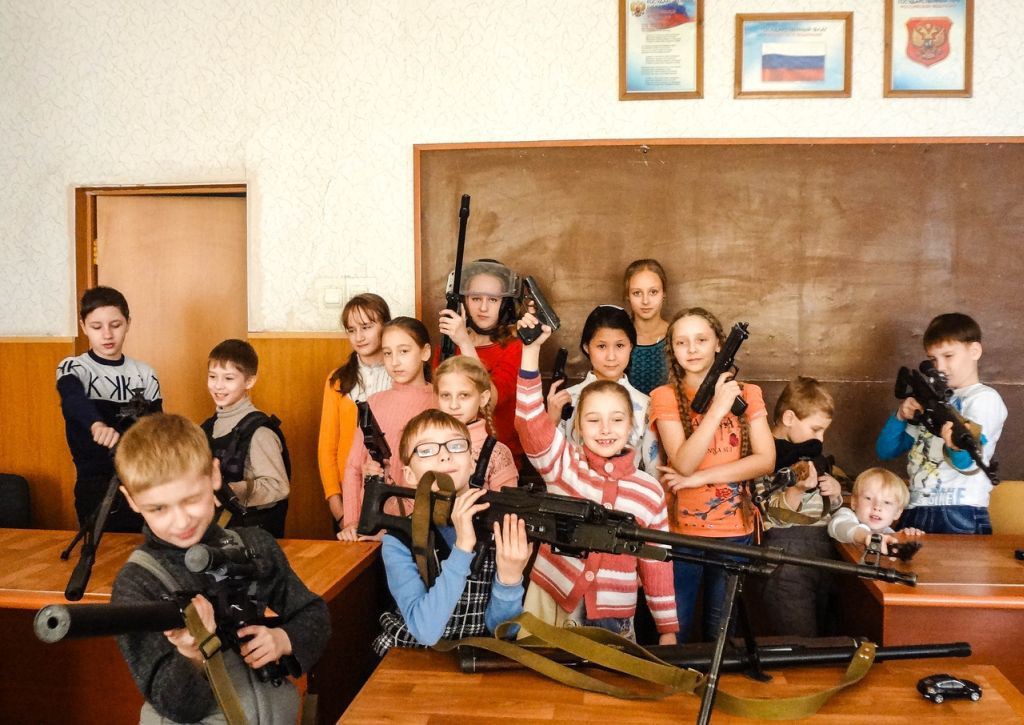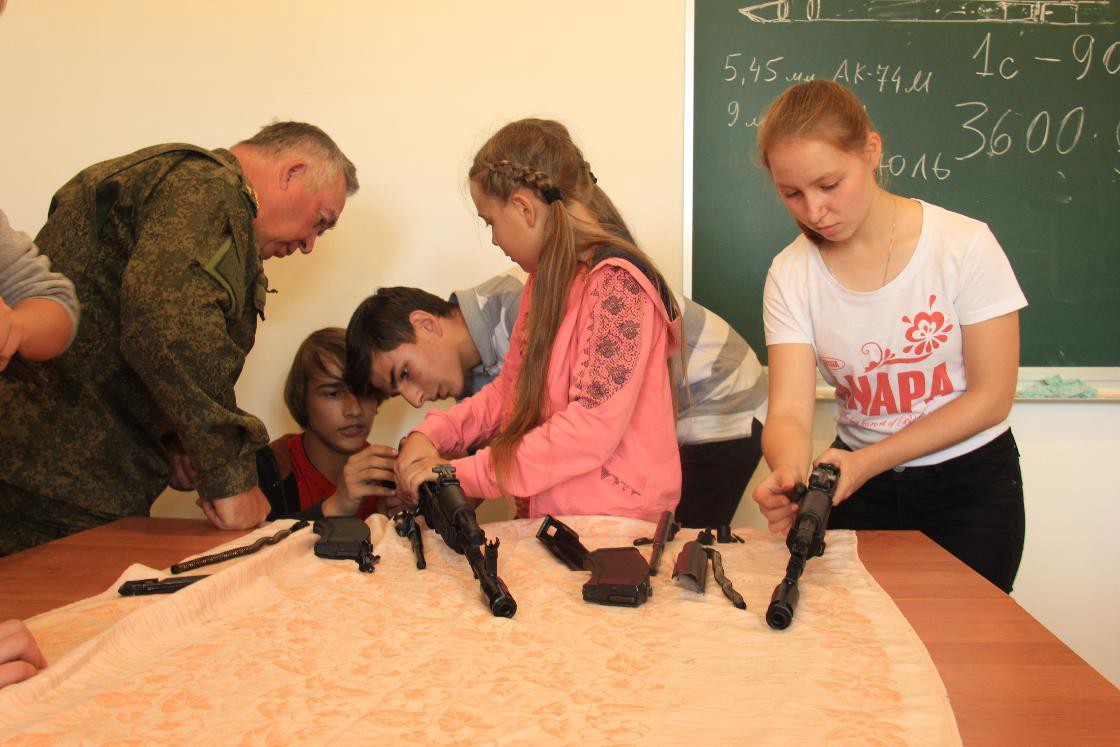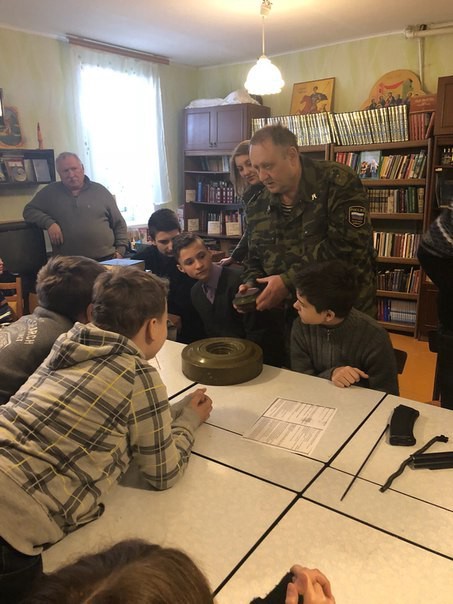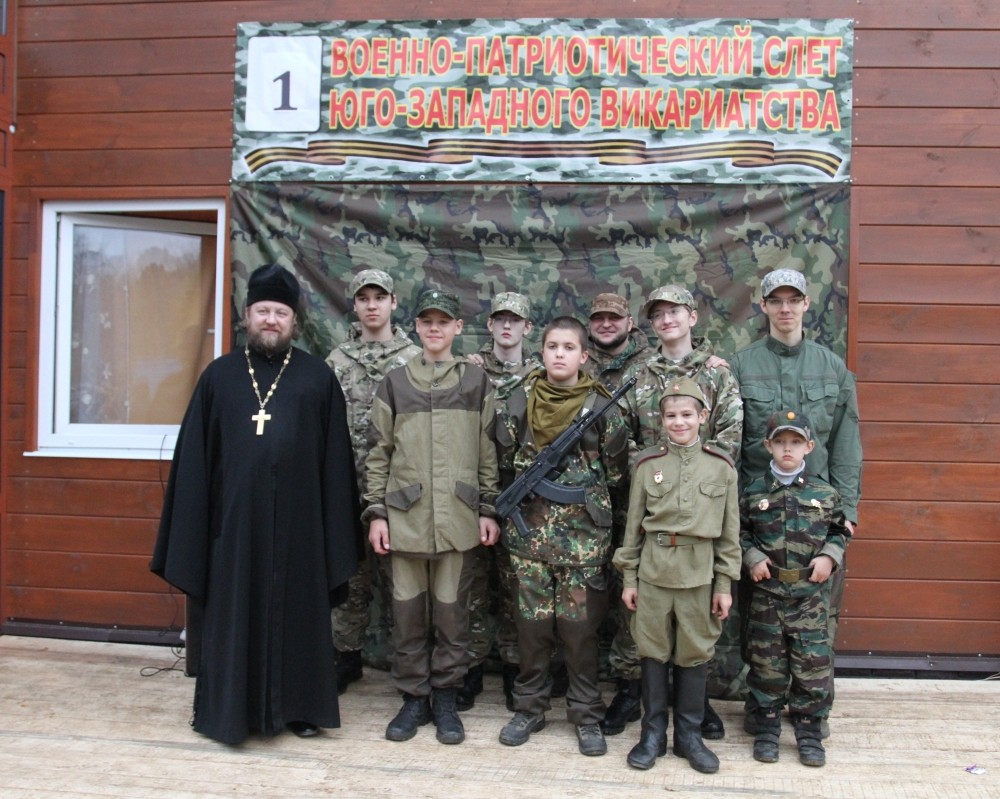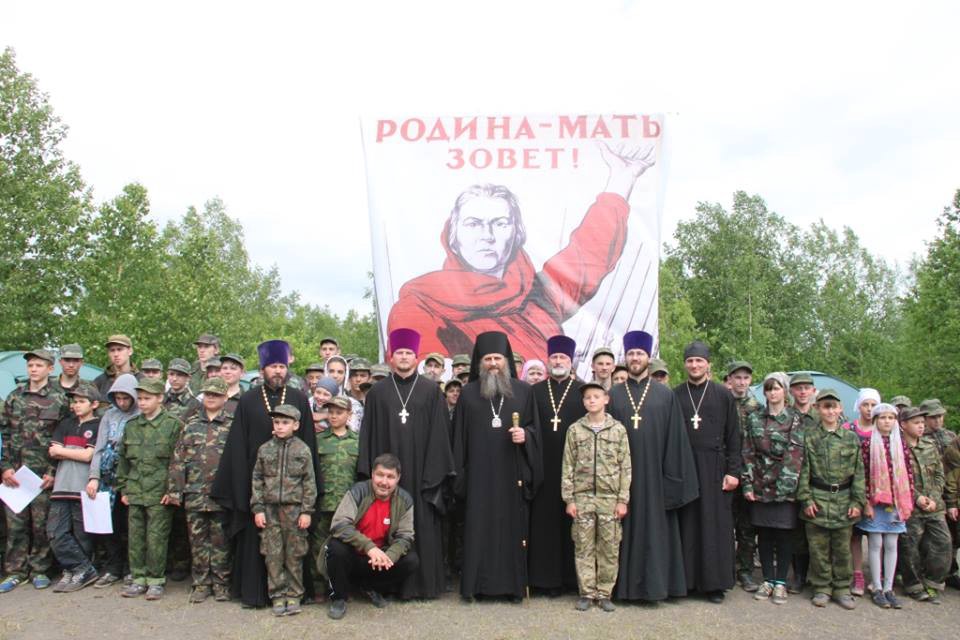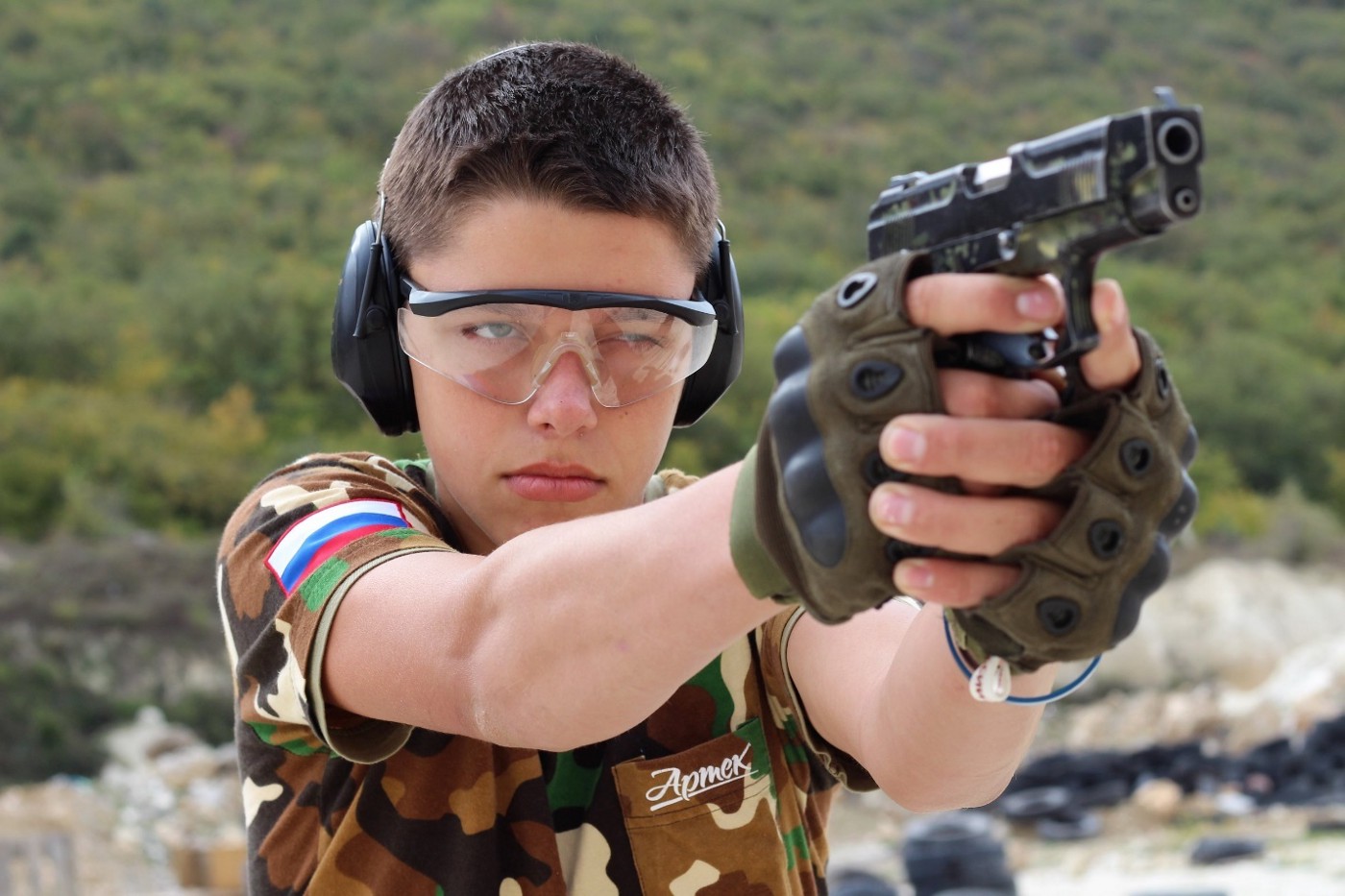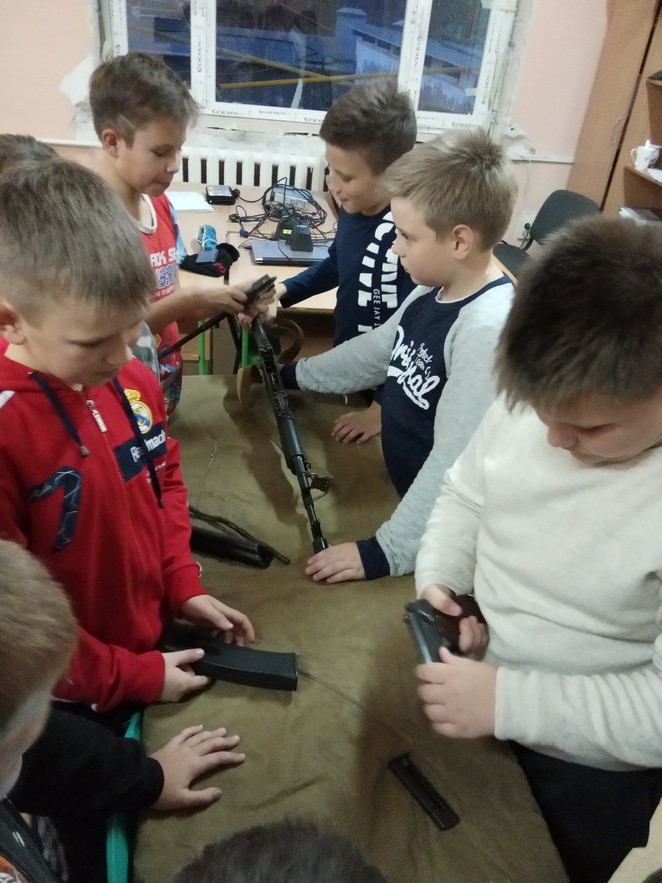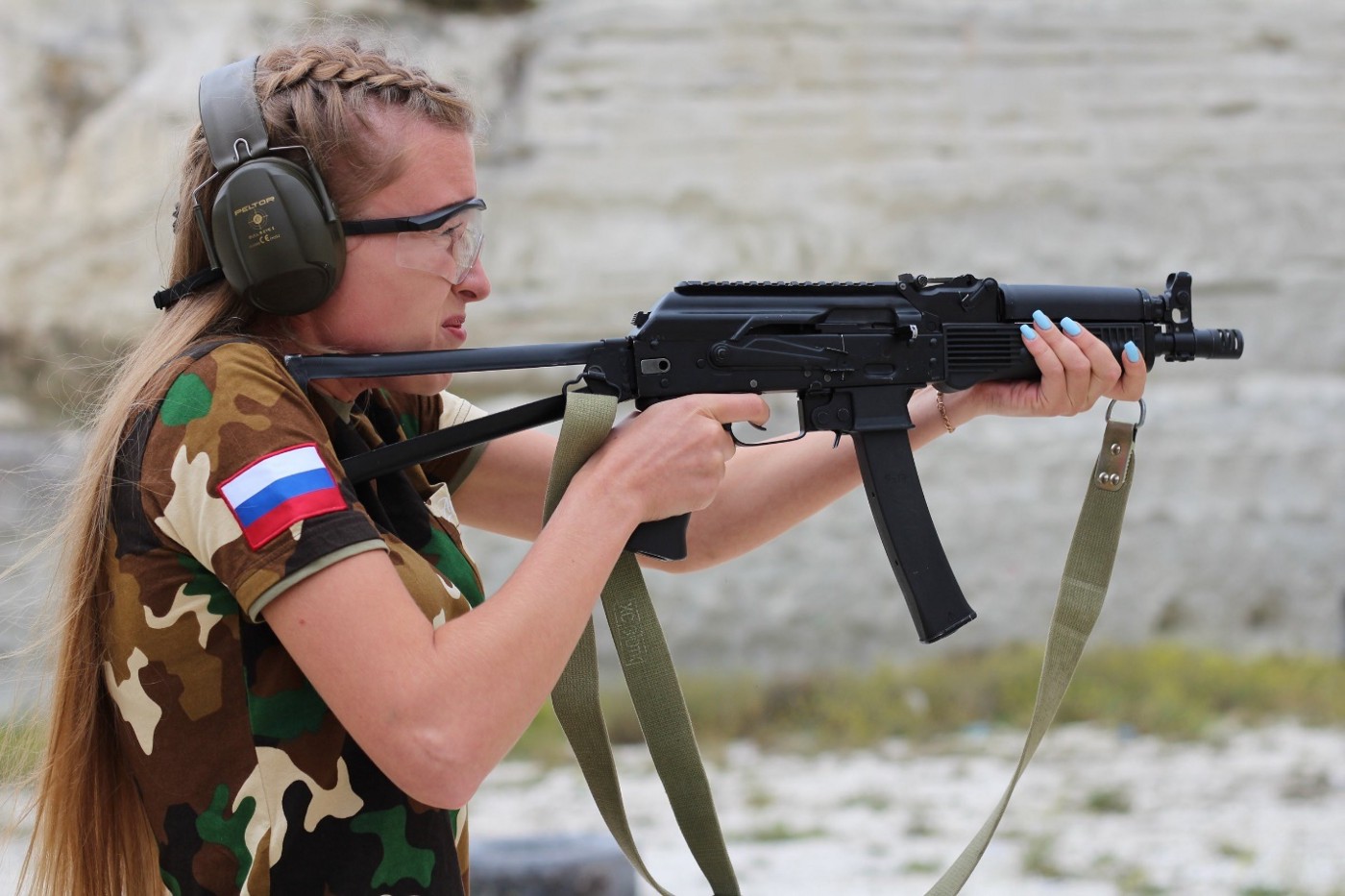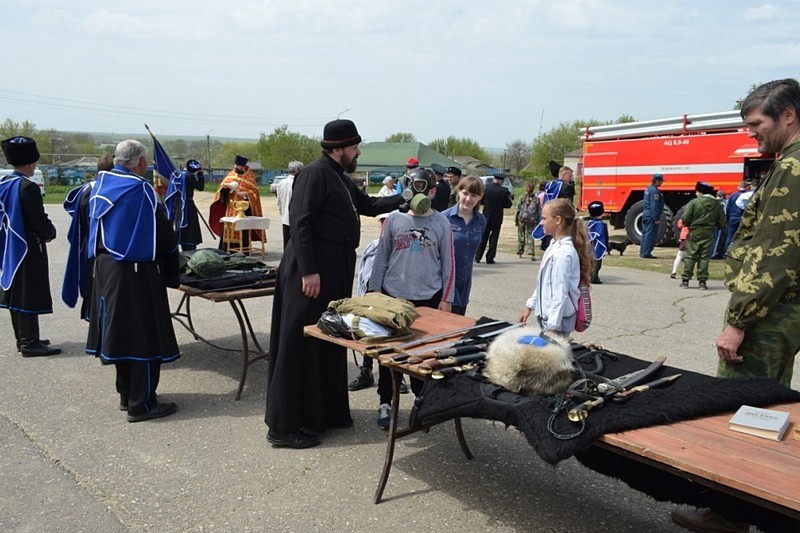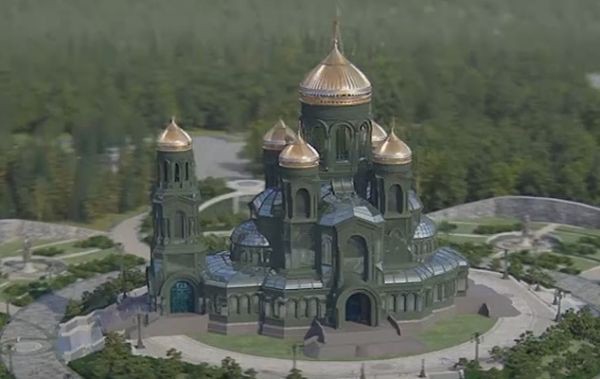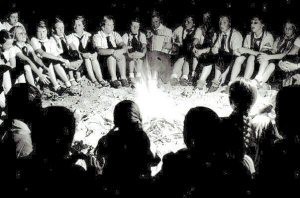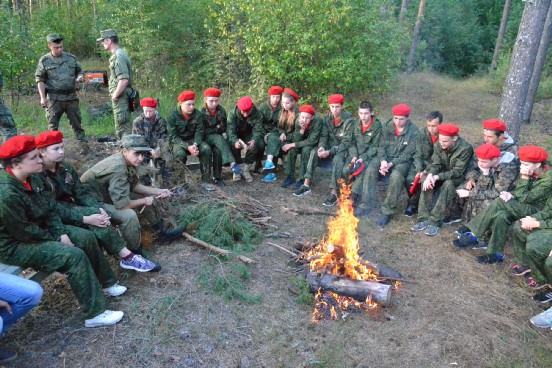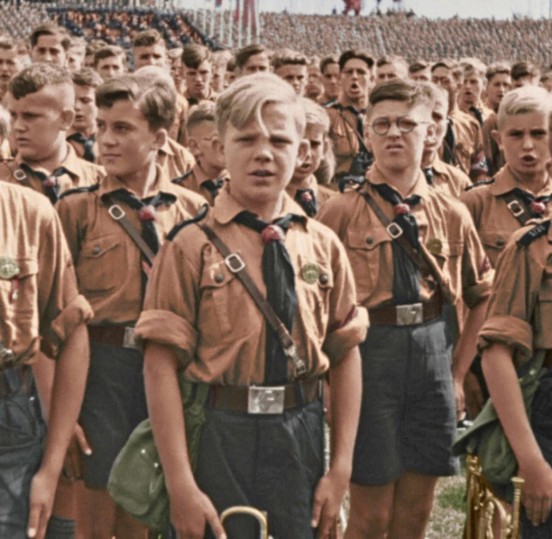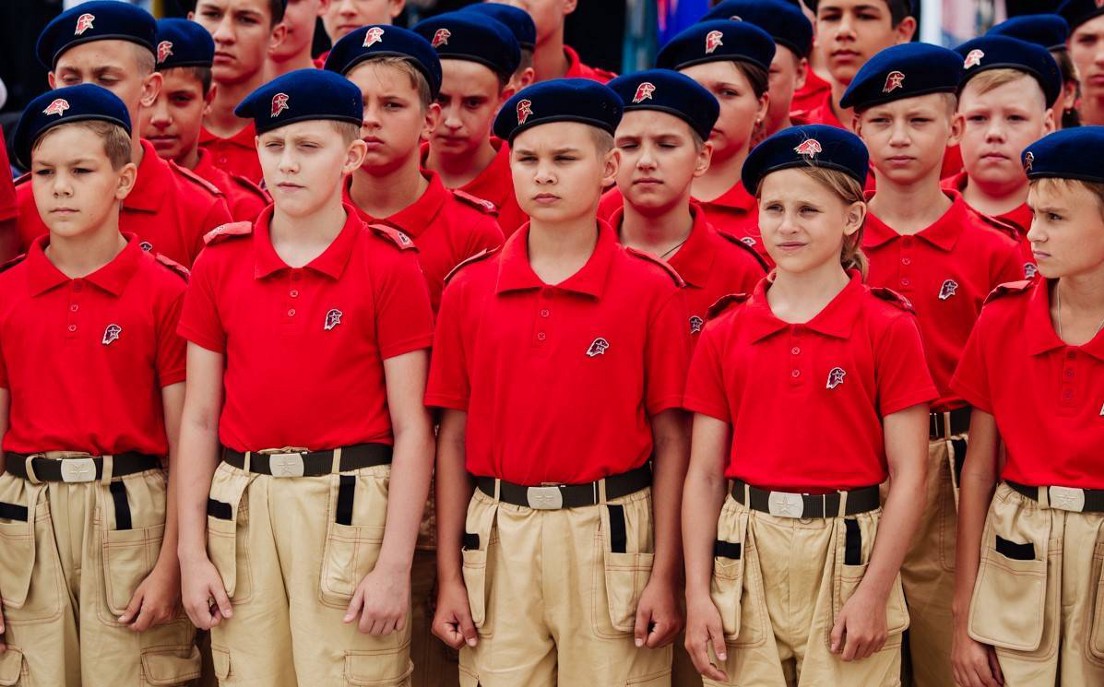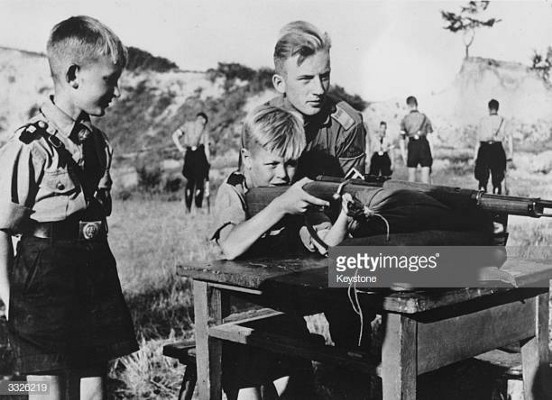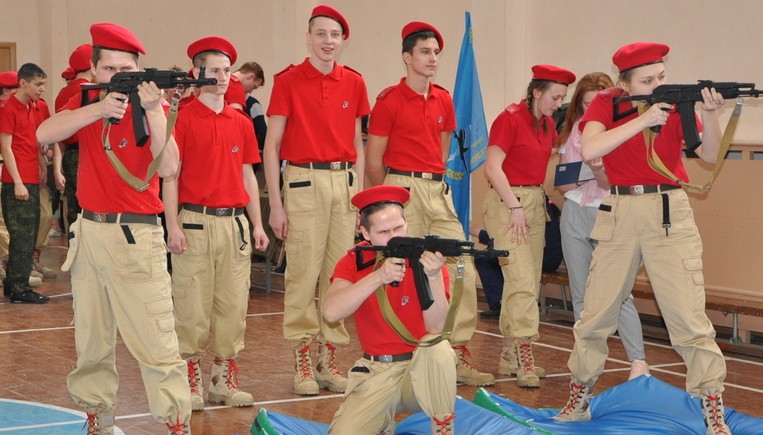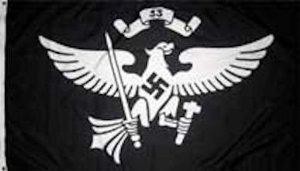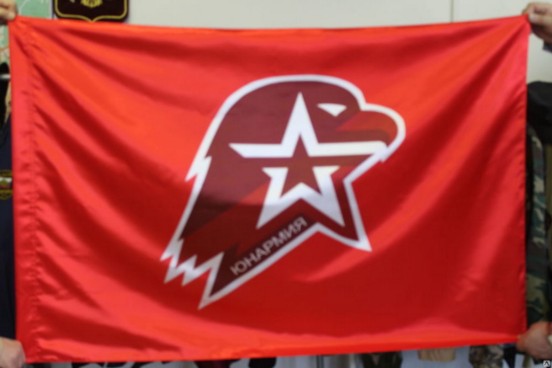This is a translation of the original InformNapalm article, authored by Andrzej Leszkiewicz and Andrii Luchkov. Translated by Hybrid Warfare Analytical Group.
After Russia attacked Georgia in 2008 and Ukraine in 2014, militaristic policy has become a norm for Russian society. Moreover, military propaganda is directed not only at the adults — it also targets children. The Kremlin actively influences the yet unshaped child identity and attempts to instill the idea that participation in Russian wars is a sacred duty of every citizen. Propaganda is amplified by the actual military training aimed at children with the goal of their future involvement into military operations. It should be noted that military propaganda efforts engulfs not only Russian children but also those living in the occupied territories as well as children from the countries allied with Russia (Belarus, Serbia). Such militarization constitutes a threat both for the underage children and for the states which are potential targets of Russian aggression — or have already become its victims.
Specific facts and events related to intensive child militarization processes in Russia sometimes catch the attention of mass-media in Ukraine and worldwide. Nevertheless, this process deserves systematic scrutiny, as child militarization has already become an inseparable part of Russian governmental policy directed at getting the state ready for expanding military aggression. During the last 10 years a well-organized and far-reaching system of underage military training was built in Russia, which grows fast and engages more and more youth, including pre-school children. Instead of searching for and developing scientific, technical, cultural or humanitarian talents, the Kremlin chooses to build a multi-million army — it conducts large-scale search and selection of recruits, and gets them ready for the upcoming wars.
As of May 8, 2019, more than 500,000 children joined the all-Russian militaristic movement “Youth Army”
This article is a collection of data on a system of the underage military training in Russia, on the territories occupied by Russia and in the states allied to it. As for now, Ministry of Defense, Ministry of Education, FSB [Federal Security Service], Ministry of Emergency Situations, Investigative Committee as well as other state bodies, Russian Orthodox Church (ROC), different paramilitary organizations are involved in the military training of children aged 3–18 years old.
In 2009 President of Russian Federation Putin restored the Soviet paramilitary organization Voluntary Association for Assistance to Army, Air Force, and Navy. In its turn, it became a base for establishing the militarized children’s organization “Youth Army”. Putin and Shoigu (Russian Minister of Defense) created the“Youth Army” in 2015–2016.
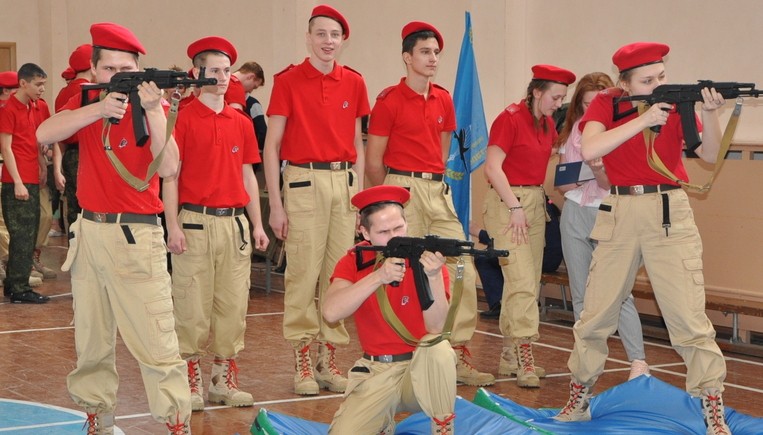
On June 21, 2018, State Duma MP, armed forces colonel Roman Romanenko became a Head of the “Youth Army” General Staff. “Youth Army” General Staff is comprised both of the armed forces representatives and various statesmen, politicians, propagandists, athletes, e.g.: Head of the Defense Ministry’s Personnel Directorate, Colonel Mikhail Baryshev; Head of State Patriotic Education Department at the Armed Forces Main Personnel Directorate, Colonel Sergey Gusev; President of Military Tactical Games Federation, actor, producer, anchor Mikhail Galustyan, International Olympic Committee member Russian Federation Armed Forces Major Elena Isinbayeva; general producer of “Match TV” federal TV-channel, producer, anchor Tina Kandelaki; daughter of Russian Minister of Defense Ksenia Shoigu; Dmitriy Rogozin’s son Alexey Rogozin.
General Vladimir Shamanov, a former Russian Air Force commander who has been accused of complicity for war crimes in Chechnya, became the Head of Moscow division.
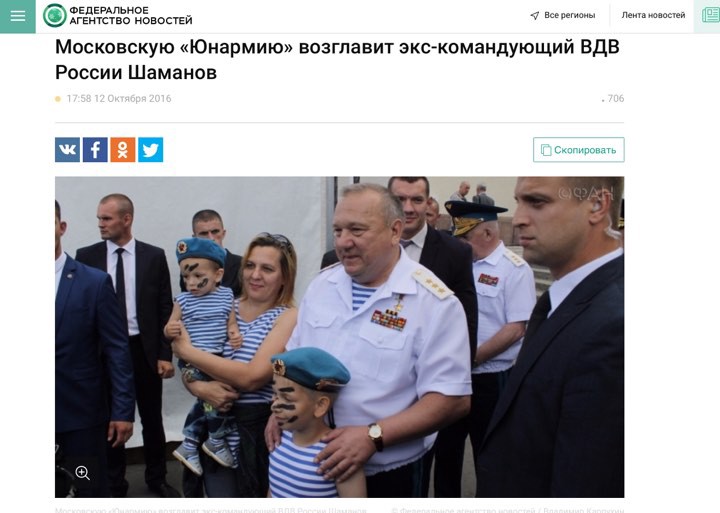
Uniform (tan-colored trousers and boots, red caps and red T-shirts with a logo — an eagle with his head turned right, a star as a symbol of Russian armed Forces and “Youth Army” inscription) has been designed by Russian Ministry of Defense.
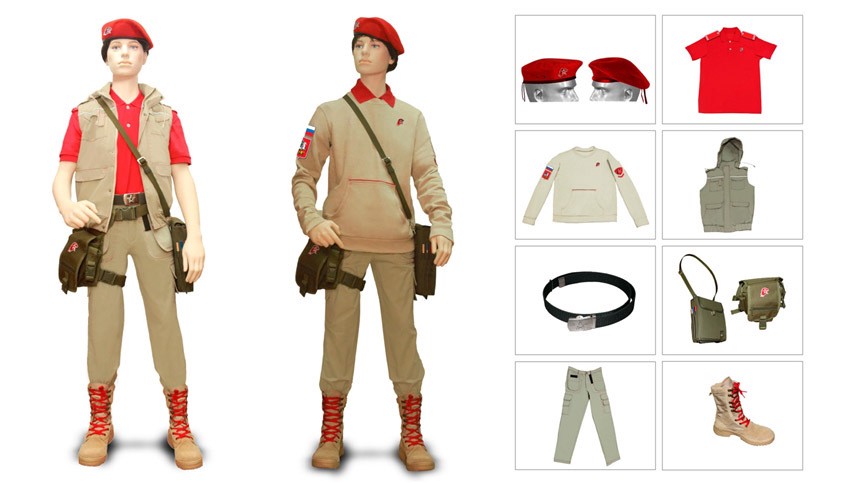
One of the “Youth Army” curators in the Russian Ministry of Defense, Deputy Minister and armed forces General Nikolai Pankov announced in 2017 that there are no plans for the rapid growth of the “Youth Army”. Nevertheless, by November 2018 the “Youth Army” confirmed having 272,000 members (children aged 8 to 18 years), and on May 2019 the number of “Youth Army” members grew to 501,000 children.
At the beginning of March 2019, the Russian Ministry of Defense announced it plans to open more than 500 “Youth Army” centers all over the country, based at the officers’ clubs and military training and patriotic education centers. According to the plan, financing, opening, and functioning of such centers would be provided for by the Russian Ministry of Defense.
First Deputy Head of the “Youth Army” General Staff, Lieutenant General Viktor Buslovskiy at the beginning of 2019 voiced a task set by Minister of Defense Shoigu — to ensure there are 500,000 members of the “Youth Army” by the end of 2019. Still, as soon as February 26 First Deputy Head of the Main Military and Political Affairs Department of the Armed Forces, General Alexey Tsygankov claimed that the Ministry expects such a rise in numbers by May 9, 2019. Moreover, numbers are expected to double by May 9, 2020, and reach a 1,000,000 members mark:
“Before the 75th Great Victory anniversary it is planned to raise the number of the “Youth Army” participants up to 1 million people” — Elena Slesarenko, Deputy Head of the “Youth Army” General Staff.
In his turn, Deputy Minister of Defense, Head of the main military-political department of the armed forces Andrey Kartapolov stated that in 2019 the “Youth Army” must emerge in all the Russian schools (approximately 42,000 schools).
At the same time, there is further and further evidence that participation in the “Youth Army” becomes obligatory:
“Group where my grandson studies are practically forced to join the “Youth Army”, [they] thought of coaching 10-year-old child how to handle a gun and so on”.
“[My] son is in the 5th grade. It’s been announced that the whole group must join the “Youth Army”. Can one refuse? And what’s the point in making enemies? There’s nothing to be done, although I dislike the idea. Children are forced to crawl in the dirt and get ready to die”.
“Actually, this issue is not new, but it was precisely this year [2019] when an informal order has been “passed down” to have a “Youth Army” division in every school. This, in confidence, was confirmed by the headmasters of the majority of schools to which our editorial staff turned with respective questions… We were firmly advised to get into this issue, with specific numbers being voiced: no less than 5% of the schoolchildren have to be “Youth Army” members”, — one of the headmasters tells.
There is also a word about attempts of the Russian armed forced commandment to forcibly entice officers’ children into the “Youth Army”.
In the middle of February 2019, the Ministry of Defense also set a “Youth Army” development task for the military-industrial complex enterprises: to establish the “Youth Army” departments at each enterprise and to organize military-patriotic divisions and clubs. Minister of Defense Shoigu’s interest in the “Youth Army” development is noteworthy:
“Sergey Kuzhugetovich pays a lot of attention to the movement’s development, supporting this initiative means supporting [him] personally”.
So as to raise the “Youth Army” membership numbers, aside from coercion, incentives are also used.
“More than 20 higher education institutions in Russia have decided to opt-out for the “Youth Army” members during the admission process. They have agreed to add extra points [for the “Youth Army” members] to the Unified State Exam”, — Roman Romanenko, Head of the “Youth Army” General Staff, March 29, 2019.
Not only do the membership numbers of the “Youth Army” grow; so does its structure. At the end of 2017, “Youth Navy” appeared within its structure. A respective cooperation agreement between the “Youth Army” and the Ministry of Transport was signed by: deputy Minister of Transport, Head of the Federal Maritime and River Transport Agency Viktor Olerskiy and (already ex) Head of the “Youth Army” General Staff Dmitriy Trunenkov.
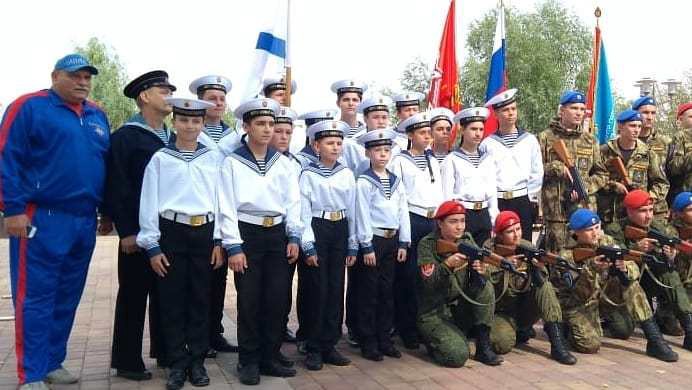
“Youth Army” members undergo courses on different military disciplines, get familiarized with military equipment, fire automatic arms, do parachute jumping, perform reservist training in camps and at the training grounds.
Military training for the “Youth Army” is held both during the extracurricular time and instead of classes as well.
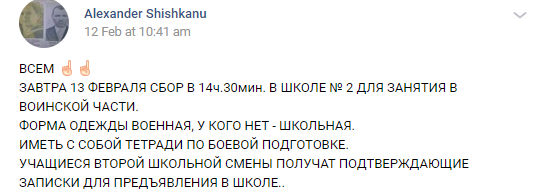
“Youth Army” is a part of Russian military training system directed at children that is most famous outside of Russia itself. Some of the regime critics unofficially call it “Putinjugend” (as an analogy to “Hitlerjugend”). Nevertheless, “Youth Army” is just a small element of a complex underage military education system. The scale on which Russian children are involved into military training is much broader.
Russian Ministry of Defense oversees the so-called cadet corps and cadet schools. Cadet corps are boarding schools for military training directed at the high school students (starting with 11 years old). When limited, such a form of military training is a typical practice in various countries, including Ukraine.
During the last 10 years Russia, however, has gone far beyond. Russian Ministry of Education (in coordination with Ministry of Defense, FSB, Ministry of Emergency Situations, Ministry of Internal Affairs, Investigation Committee and other governmental bodies) orchestrated opening of the thousands of cadet classes in regular schools. Cadet class is a specialized military class in a regular school (for children aged 7 to 18 years old). Children in such a class wear military uniform on daily basis, and after the regular curriculum classes stay at school for the military training during the second part of the day. Depending on the school, cadet classes are available for children starting with 5th (11 years old) or even the 1st grade (7 years old).
In 2014 Russia already had 177 cadet corps of the Ministry of Defense (almost 62,000 children) and 7,000 cadet classes in regular schools of the Ministry of Education (with 20–25 students per class it estimates to 140–175,000 children). Nevertheless, from 2014 onward a lot of new cadet classes were established. For example, in Moscow the first cadet class appeared only in 2014 (there had already been a significant number of them in the regions), but in 2017 168 schools had cadet classes. As of 2018, there were 12,500 children studying in Moscow cadet classes. In the regions, the number of cadets also grows rapidly; for example, in Privolzhskiy federal district, where lives close to 20% of the Russian population, there were 22,000 cadets in 2012 — and 41,000 in 2017. Therefore, by 2018 the overall number of children studying at cadet classes could reach several hundred thousand. And these are the children aged 7 years and above from the regular schools. These children wear a military uniform every day and, in addition to the regular curriculum, attend military-directed classes (ranging from military history to firearms training), go out to the training grounds.
Depending on which institution or organization curates a cadet school (class), there are varying types of classes. It also depends on the nearby military units and/or higher military education institutions that may cooperate with the school. This is how military law and military engineering, marine, navy, air force (Ministry of Defense), border control (FSB), Investigative Committee, Ministry of Internal Affairs, Ministry of Extraordinary Situations, “Cossak” cadet classes are formed.
A series of 12 videos uploaded by Mikhail Asankin (actor, anchor, propagandist) reveals the education process at a cadet class (“Cossak unit”), school №60 in the city of Yaroslavl:
Not only does the quantity of children involved in the military training system grows; so does the quality of the training itself. Specialized classrooms, shooting ranges are established; firearms simulators, training ammunition is purchased, including mines, grenades, and other equipment.
Quote from the video: “… gymnasiums and lyceums are obliged to have a shooting range or shooting simulators, otherwise, the prosecutor’s office will ask them to do it…” (2014).
The Kremlin pays special attention to militarizing the orphans. These underage children are fully dependent on the state and have no option to reject participation in such initiatives and morale-building activities.
On July 12, 2018, a new Kremlin project “Youth Army. Guidance” was launched. Moreover, the secretariat of the Russian children’s rights ombudsperson has also become an instrument in building a system of child military training.
“Today is an important day: we announce the start of “[Youth Army] Mentorship”. It is needed, first and foremost, by children who were left without parental care. Only 10% of orphanage graduates manage to settle well in life. We understand that these children need not just a place to live, not just financial, legal and other assistance. These children require support, require advice, require a friend. It is very important to have a mentor”. [archive] — Anna Kuznetsova, Russian children’s rights ombudsperson.
“Secretariat of the Children’s Rights Ombudsman Anna Kuznetsova passed down instructions for all the regional ombudsmen to sign an agreement with the “Youth Army” headquarters… The pilot project in 8 regions (30 orphanages) finished last year, and it was then that Kuznetsova announced the start of the main stage — everywhere”. [archive]
On March 12, 2019 Secretary of the Security Council of Russian Federation Patrushev announced that “the issue has been solved with directing underage persons inclined to commit crimes to military-patriotic camps”. It is known that in Russia amnesty is already practiced for those facing criminal charges with sending them to the occupied territories in Ukraine to take part in the war. How much will these children, trained by the senior war criminals in the military-patriotic camps, be prone to committing war crimes themselves?
Putinjugend spreads quickly not just onto schools, but onto kindergartens as well. Small children are taught to sing military songs, model and draw military equipment, play military games (“Zarnitsa”, for small children — “Zarnichka”), handle arms, wear military uniform on daily basis. Practically, children in many kindergartens already undergo actual military training (as far as possible at the age of 3–6): full-fledged “cadet groups” are formed, where children wear a uniform daily, learn the army structure, types of military equipment and arms, learn how to follow orders without question.
Veterans from wars in Chechnya, Syria, and Ukraine were also put to work in Russia’s kindergartens. Men with combat experience, complicit in war crimes, become educators for pre-school children.
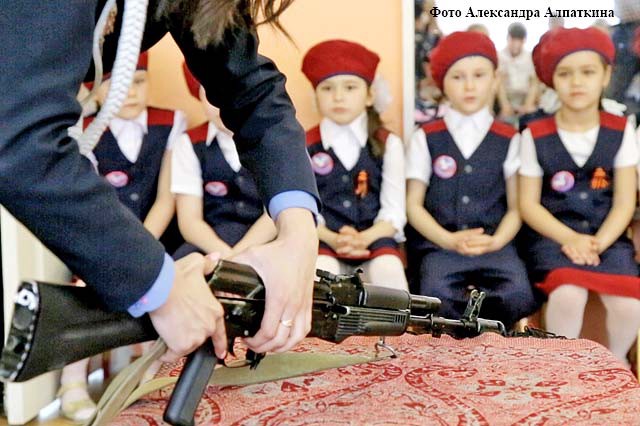
Actual and not toy guns appear in the hands of the smallest children.
Cadet classes in schools cooperate with cadet groups in kindergartens, take part in teaching the younger generation of cadets. Cadet groups graduates then become students of the cadet classes in schools. This is how a unified military training system for children aged 3–18 years is created.
“Our graduates continue their studies in cadet classes and schools” [archive]
Several examples of people conducting military-patriotic training for children.
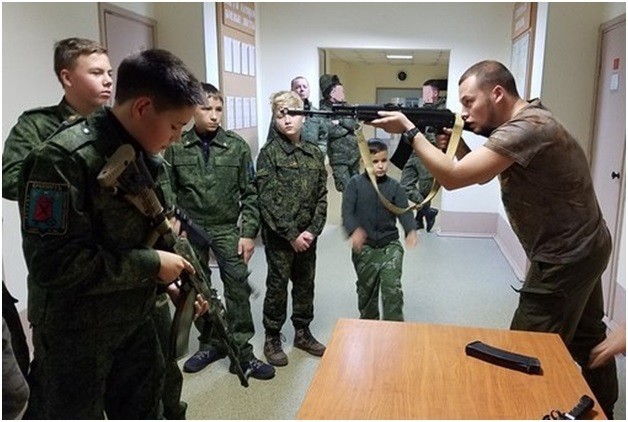
The photo features no one other than Alexey Milchakov (profile on Myrotvorets): “Russian mercenary. Was a participant of the secret subversive group “Rusich”, commander. Extremely dangerous Russian killer-terrorist with mental issues. Took part in the occupation of Crimea as a part of Russian forces, in combat in Donbas and SAR. Member of the Donbas Volunteers Union”.
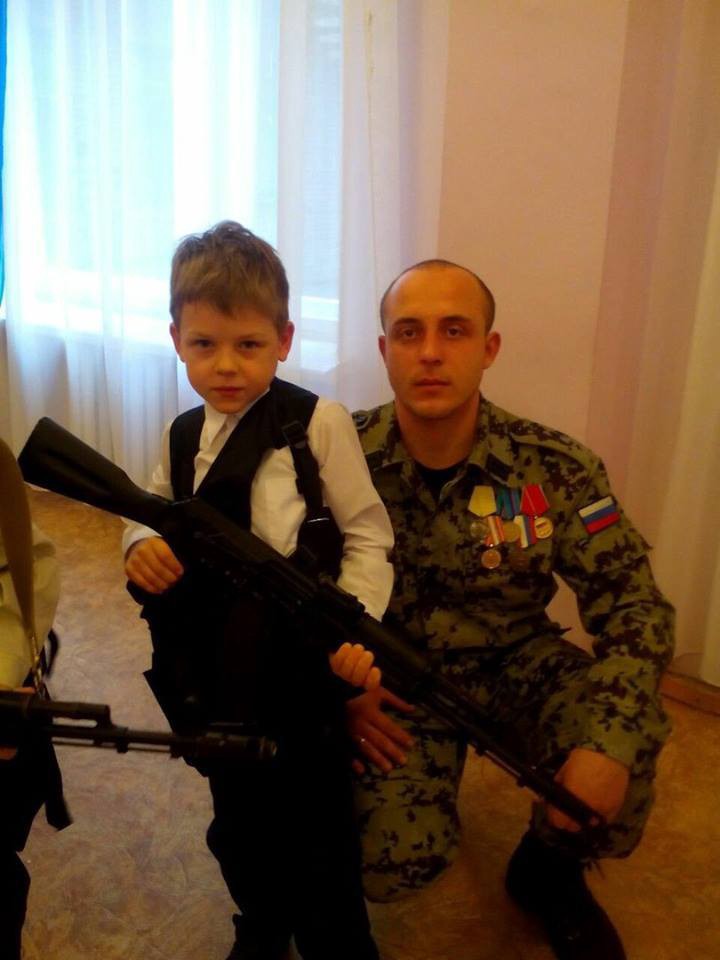
Borys Syretskiy (link to “Myrotvorets” profile): “Syretskiy Borys Oleksandrovych. Russian mercenary, militant of the illegal armed formation on the territory of Ukraine (secret subversive group), sniper; he was spotted in a camouflage suit “Leshiy”. Russian Bashkarov-Nazi from the “Russian national unity” *(Aleksandr Bashkarov — leader of this organization). According to his mother, Boris is an addict. Repeatedly convicted, including the sentence of Yeysk city court at Krasnodar area from 10 November 2011 according to article 1 section 111 of Criminal Code of Russian Federation (“Deliberately inflicting severe damage to health dangerous to human life”) up to 2 years and 6 months of imprisonment with serving a sentence in a correctional colony of general regime”.
Not only students of cadets school classes and cadets ’kindergartens’ groups are involved in military training and become subjected to propaganda. The rest of the children are engaged in other forms of similar activities.
For example, in the Russian education system, May 9 and February 23 are no ordinary holidays. Honoring these dates at schools and kindergartens is accompanied by monthly military-patriotic training. Usually, it is one month in January-February and another in April-May. During these two “monthly training” children play military games (as “Zarnytsya” at schools and “Zarnichka” at kindergartens), visit military bases and military museums, have issue-related lessons, competitions, demonstrations, wear military uniform and sing songs about war. In addition to this, for greater militarization impact, children are involved in the celebration of other memorable days connected to WW2. For example, “day of city/district/area/country liberation”.
The militarization of schools covers even the classes far from military issues. Here is homework from the “Russian language” schoolbook for 4th-grade students.
The announcement in the kindergarten: “Puppet-theater play “Russian soldier doesn`t know borders (afternoon)”
The peak of Russian propaganda and children militarization, in particular, the youngest ones, falls on the May 9 events, when “parades of preschool children’s army” and “parades of baby carriages” take place.
Another type of military training is military-patriotic clubs in churches of the Russian Orthodox Church. Many websites of the Russian churches contain special pages or articles with information about the existence and activities of such clubs. Military training is held in church buildings with “priests” as instructors. Besides, Sunday schools are also directly involved in military activities for kids. There are also “military-patriotic training centers” in churches. Russian Orthodox Church acts as an organizer of children’s military camps. In churches, the ceremony of taking the cadets’ oath is accompanied by a blessing from “priests” on “the successfully firing military weapons” and take a direct part in organizing other activities aimed at creating Putin’s child army.
Moreover, one of the core elements of children’s military training system is constituted by different paramilitary organizations such as Cossacks fellowships, “Donbas Volunteers Union”, “Union of Afghanistan veterans”, Russian military-historian community, “Combat brotherhood” and many others. Adult members mostly have combat experience in Chechnya, Georgia, Ukraine, Syria, and organize military clubs and summer training camps for children. As of April 2019 at least 5,500 children were members of the various military clubs in Russia.
The children’s military training system covers Ukrainian territories occupied by Russia as well:
- Cadet class (Investigation Committee) in Crimea
- Cadet class (Ministry of Internal Affairs) in Crimea
- Cadet college in Crimea
- Cadet corps in Donetsk and Luhansk
- Cadet class in Luhansk
- Children’s military training at the occupied territories of Donetsk region
- Cadets from Yamal in Crimea on military-patriotic meeting (2014)
- Summer military camp of Russian Orthodox Church (Novosibirsk) in Crimea (2015)
In the “Artek” summer camp in occupied Crimea, children are taught to fire different types of arms. “Kerch Shooter” Vlad Roslyakov was among these children.
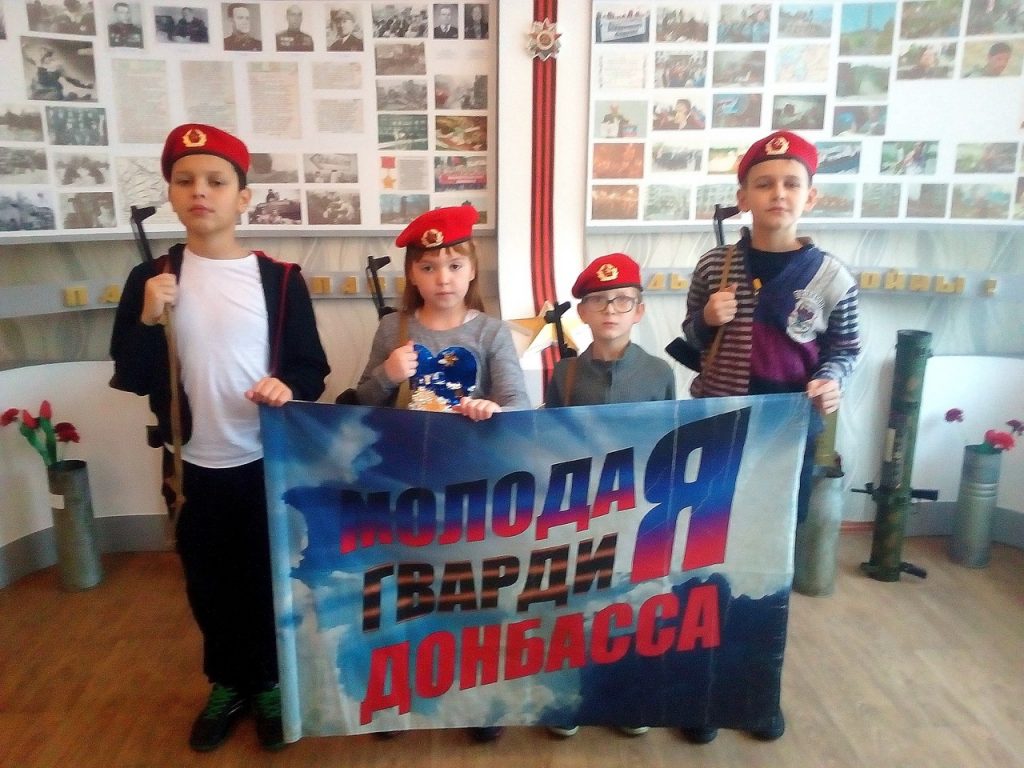
At the end of March 2019, Eduard Basurin announced that starting with April patriotic youth movement “Moloda Hvardiya— Youth Army” will be created in the so-called “DNR” (the occupied part of the Donetsk region of Ukraine). As soon as on April 5, 2019, the occupation authorities proclaimed the creation of this organization, approved the charter, appointed the head of the organization and leaders of its territorial headquarters (Donetsk, Horlivka, and Komsomolsk [Komsomolsk — the occupational name of the settlement Kalmiuske in the Donetsk region]). The head of organization was the local collaborator Victor Viktorovich Pudak, deputy head of the department for military-patriotic education and rehabilitation of the youth at the so-called “DNR”.
“…but if the chief commander summons us to the last battle,
Uncle Vova, we are with you!…
Our loyal friends are the navy and the army…
We will preserve Sevastopol and Crimea for our future generations,
We will bring back Alaska to the harbor of our motherland”.
In matters of children military training, Russia actively cooperates with its military allies — Belarus, Serbia:
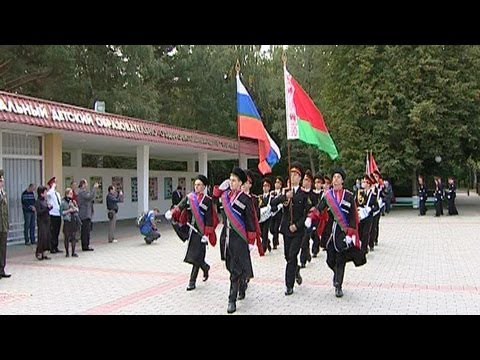
Military training of children in Russia often gets very strange and controversial forms with a religious inclination: religious texts with lyrics about war are mixed together, religious rituals are performed at military exercises, military oaths are made in temples, Orthodox icons stand next to portraits of Stalin and Putin.
Link to the video from Crimea dated December 2017: the USSR flag, soldiers, pioneers, “Stalin” with a speech about the greatness of Russia in his time and the wind of history, which will raise him from the grave. And the song “Return to Stalin, he still has to take the victory parade!”.
Link to the videos from Irkutsk (2017): Training on weapons maintenance for children. It is worth listening to the girl (in Russian, because the film itself is Finnish) between 35:45 sec. and 36:50 sec, to assess what political views children receive at the same time as military training.
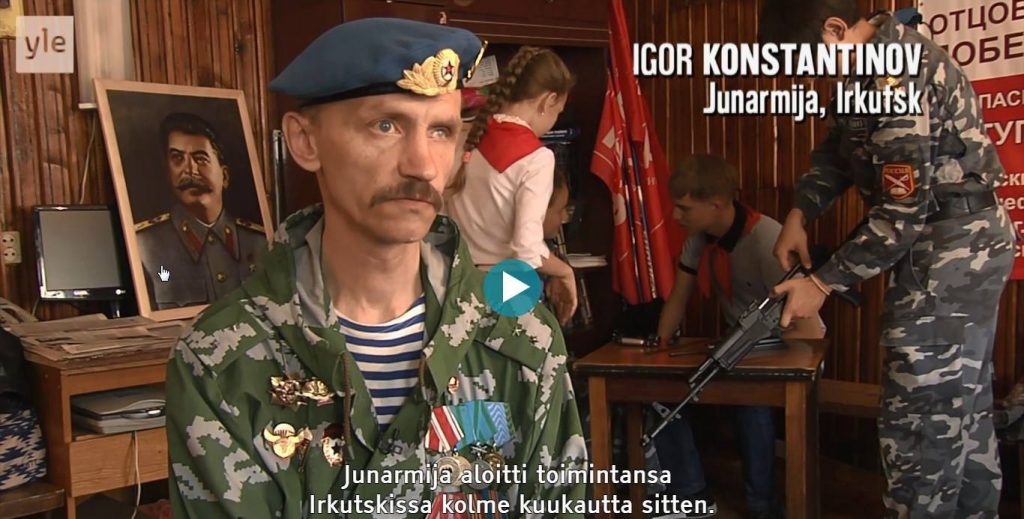
Experts claim that this militarization of the education system and society in general could seriously influence children’s personalities and their future.
“An illusory, fake picture is created for children, where the real causes of events are replaced by fictitious ones. Children are given the impression that they are surrounded by enemies, that they must unite closely to protect their home. Experience of Nazi Germany showed that propaganda instructions installed back in childhood can be taken through the whole life. Moreover, the contradictions accumulated in mind do not allow for formation of an adequate personality. This is a psychological chopper,” — Psychologist Larysa Voloshyna about the influence of militarization on children psychics.
It is quite difficult to tell for sure what the consequences of militarized education will be for the child’s mental health. That is, we can not say that this will lead to a higher proneness to mental illnesses, since there was no scientific research on this subject, and most likely it will not. However, such militarizing education and the shaping external enemy image for children could have very negative consequences. It does not just make children more aggressive but also prevents them from thinking critically in the future. These children will tolerate and support the use of violence “for the good of Homeland”. However, to adequately assess whether Homeland is really threatened by something, whether the enemy really exists — they will most likely not be able to do it,” — Maksym Rozyayev, child neurologist, specialist of the Center for Mental Health, Drug and Alcohol Monitoring at the Ministry of Health of Ukraine.
Some history in the place of epilogue. Hitlerjugend was a youth Nazi paramilitary organization of the National-Socialist party (NSDAP) in Germany before and during WW2. From 1933 to 1945 it was the only legal youth German organization. Hitlerjugend engaged the youth from 10 to 18 years old. After the German invasion of Poland in 1939, hundreds of thousands of Hitlerudgent boys filed applications to be sent as volunteers to the front. In 1945, the children of Hitlerjugend (aged 12 years) constituted a significant part of the last line of Berlin defense, most of them died.
For more information on how the system of military training of children in Nazi Germany operated, see this film (5 parts):
“Ah, how it was all well! .. Trips around the country, hiking trips, collectively seeing performances and films, music, painting, amateur art, air modeling in “Skillful hands” circles, summer camps, songs at the center, steamy soup, morning line-ups with the lifting the flag, military games … And the feeling of community, belonging to a great country and a great leader,”
— memories of a former Hitlerjugend member.
And this is Russia, 2018, comments of the Youth Army in the “Rosson” comp:
Vlada Nikitina: “I really liked the camp. We lived in classy tents and made physical exercises every day. In the evenings, we were sitting near the fire and thinking about the next day’s activities. We learned to disassemble and assemble AK 74. I advise it for fans of active recreation”.
M. Varlamov: “On this camp shift, I learned a lot about the military discipline. For younger generations, this is a very useful and informative experience … Every day a fireplace, comfortable beds, good guides. I advise everyone very much!”
Ye. Alekseev: “It was great! The tents are comfortable, warm and have everything you need to live. Very funny guides. Good friends! Liked everything!”
Youtube playlist with more than 900 videos on children military training in Russia only confirms that these have not been separate local initiatives, but a purposeful state policy on behalf of Moscow.
The involvement of pre-school children in military training as well as the role of the Russian Orthodox Church (ROC) in the child military training system in Russia are so broad and cynical that they deserve further expanded articles. To be continued…
*Please note that some of the photos containing large amounts of Ukrainian and Russian text have been reducted from the translation. They are available in the original publication.

